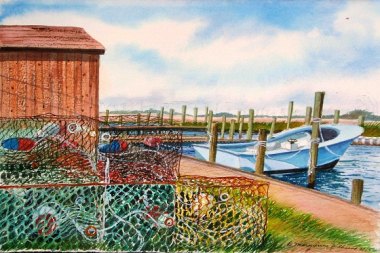Saltwater Connects Non-Profits, Naysayers and Non-Natives

That question sparked conversation at the April Saltwater Connections meeting on Ocracoke.
Saltwater Connections is an initiative to "increase the region’s economic prosperity by building upon, rather than sacrificing, our cherished cultural and natural heritage," according to www.saltwaterconnections.org. The grant funds conversations on and between the 21 unincorporated villages along Hatteras, Ocracoke and Down East.
The number of charitable organizations on Ocracoke may be as high as 30, said Sara Mirabilio, a member of the Saltwater Connections resource team. The group identified 14 active non-profits with 501(c)3 status.
"You can't rely on a government entity to take care of community based projects," said Karen Amspacher of the Core Sound Waterfowl Museum and Heritage Center, who coordinates Saltwater Connections.
"Is there non-profit overlap?" asked facilitator Mikki Sager, a staff member of The Conservation Fund's Resourceful Communities Program. How well do the groups communicate with one another? Where do people go to pitch ideas? "How do we build on what's already here?" she asked.
Non-profits boards have empathy for one another, and seem to be teaming up more and sharing in projects, said Ocracoke Foundation, Inc. Director Robin Payne.
"Communication is the biggest issue," said Leslie Lanier, owner of Books to be Red.
The occupancy tax board meeting is always educational. Maybe groups should meet a month before that annual meeting to see if it makes sense to combine efforts, suggested Gene Ballance.
The Saltwater Connections resource team proposed forming an informal coalition of groups active on Ocracoke. More than one person pointed out that no one wants another meeting to put on their calendar, but would be open to a gathering that offered a chance to interact with people from different organizations.
We should "emphasize awareness" of the projects others are working on, said Payne.
The dozen Ocracoke residents participating in Monday's meeting decided to send an email and short survey to non-profit board members to see if there is interest in the idea.
It can often seem as if the same people are active on a number of projects. "The people who get things done are the people who do things," said Ken DeBarth. How can more people be included in making decisions that effect the whole community?
A personal invitation works well, said Ruth Fordon. Put a draft of the Saltwater Connections initial report in someone's hands and invite them in, she suggested.
"Somebody's got to speak for the people talking in the background," said Lanier, recognizing that not everybody has the time or inclination to attend meetings.
In a community as small as Ocracoke, it can be challenging to voice an unpopular opinion. "Agreeing to disagree is a learned skill," said DeBarth.
"Naysayers often have good points," said Sager. Value these voices, she urged.
Sager pointed out that one group is woefully under-represented in decision-making. To involve the Hispanic community, inviting more than one person to serve on a board can help alleviate the discomfort of being the only visibly different member, she said.
Also engage the young people to tap their energy and translation skills, advised Sager. Most importantly, go into the Hispanic community. "If you're willing to make yourself uncomfortable that's a good step toward building the trust."
Everyone is welcome to attend the monthly Saltwater Connections meetings. Learn about the March meeting from this earlier article in Ocracoke Current!



